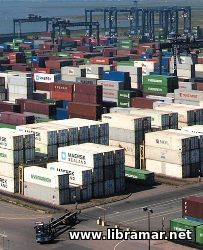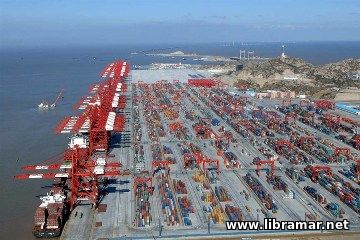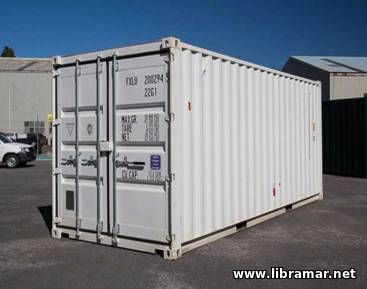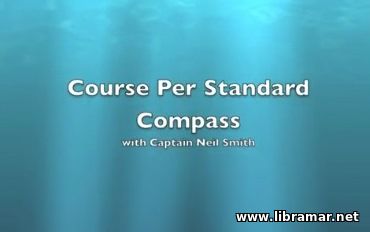Container Operations

Computerized Container Operations
The organization and efficient execution of the loading and unloading operations of a containership is a complex task. Careful coordination and planning of both manpower and equipment is required to obtain the most economical results. Because of its complexity, computer-based data processing and handling technology is of great assistance to the human operator in the efficient execution of this task.
Certain programs were created and installed on the General Electric Mark III Network for use by U.S. Flag operators in the United States. In addition, communication satellites provide U.S. operators access to the same programs and data banks from many maritime jurisdictions including Puerto Rico, Australia, Hong Kong, Japan, and Western Europe. The only user equipment required is an interactive computer terminal, a telephone, and a GE user's number.
a. Ship Inbound.
As the ship approaches the pet, the data files listing the containers on board, the ballast, and the fuel conditions upon arrival are accessed and modified, if necessary, by the Cargo Supervisor.
Additional files are created which contain sorted data to allow generation of summaries, maps, and lists of containers for unloading, reloading, and those remaining on board. The Cargo Loading Supervisor can:
• obtain the fuel burnoff, bunkering, and ballast conditions from the previous port,
• make changes to the liquid conditions based on projected arrival date,
• obtain container summaries, maps, and listings from the previous port.
Based on the expected trade and the containers already on board, each hold is dedicated, according to a loading strategy, to a particular destination, mix, commodities or container size. Using a statistical distribution of container weights, a set of target loading weights for each available container position is generated based on ship stability, draft, and stress requirements. The Cargo Loading Supervisor can make changes:
• to the expected or anticipated loadings,
• to the resulting hold allocations,
• to the selective loading weight allocations
The dock file of containers for loading can be updated prior to the specification of loading instructions. Additional containers can be entered in the dock files as they arrive at intervals desired by the Supervisor.
The Cargo Loading Supervisor can:
• obtain listing and summaries of the containers on the pier.
• obtain listing for each port.
• assign a fixed location on the ship for special cargoes.
Instructions are generated to achieve the best match between available containers and the desired container for each cell to be loaded. Loading and discharge instructions are determined under control of specific availability and ship attitude constraints. An updating routine is used to verify those instructions unsuccessfully accomplished; exceptions and additions are made for those instructions not properly completed. The Cargo Loading Supervisor can:
• select hold to be worked,
• select number of cranes,
• provide ship checkers, terminal, and yard personnel with copies of the detailed loading instructions,
• make changes to the files for incorrectly located containers,
• obtain summaries, listings, and maps of loaded holds,
• load late arriving containers directly.
b. Ship Outbound.
After completion of ship loading, the Cargo Loading Supervisor can:
• obtain ship summaries, maps, and listings of the loaded ship,
• provide the master and/or first officer of the vessel with these as part of the cargo manifest documentation,
• provide the first mate with fuel and ship conditions for the outgoing voyage,
• establish the ship and container files for the vessel's next port of call.
 Computerized container operations provide the Cargo Loading Supervisor and terminal personnel with the required documentation and control to assist them in the efficient loading and unloading of containers. Many of the following computer-produced documents can be used directly by loading personnel:
Computerized container operations provide the Cargo Loading Supervisor and terminal personnel with the required documentation and control to assist them in the efficient loading and unloading of containers. Many of the following computer-produced documents can be used directly by loading personnel:
• summary of ship weight, attitude, and stability characteristics,
• summary of containers by hold, length, and destination,
• map of containers in the hold,
• list of containers by hold, identification and special handling, destination, weight, and exact ship location,
• listing of the containers on the dock, location, identification and special handling, weight, and destination,
• hold allocation by container size, destination, and above or below deck location,
• selective loadings with target weights for each available position,
• sequential loading/unloading instructions with container identification, dock and ship location, and ship attitude.
Loading Rates and Other Study Related Data
For the purpose of designing systems and/or making comparative studies, it is useful for the naval architect to have the cycle time for different types of operations. A cycle is defined as the average time required for the transporting device to acquire a container, to pick the container from the hold, move it out of the hold on to a dock mounted vehicle, release the container, and return to the hold position ready to acquire another container. The designed time based on maximum equipment speeds is often not obtainable because of human interaction in the system and the following cycle times are based on actual experience with 40-ft containers:
• dockside gantry crane or ship mounted gantry crane of modern design — 3.0 min,
• ship mounted gantry crane where rotation of load (90 deg.) is incorporated in cycle — 3.5 min,
• twin-boom rotating cranes, single-point lift with adjustment for off-center weight — 10.0 min,
• ships heavy-lift gear, swinging boom with adjustment for off-center weight — 15.0 min,
• general cargo ship gear doubled up utilizing one set of gear at each end of spreader — 15.0 min.
For smaller containers (i.e. 20 ft and Conex boxes) better rates can be expected in the last three modes with singling up of gear because of the reduced load. It is also important to understand when making time studies that:
• hatch covers require about the time of one to two cycles depending on fittings and gear use,
• lashing and unlashing times must be added to the total container loading time as this operation cannot completely be carried on while loading or unloading,
• to obtain a cycle where one container is discharged and one full container reloaded in the ship in the same duty cycle (i.e. with a gantry crane 40 containers moved in a hour instead of 20) it is necessary to discharge the entire deck load, remove the hatch cover, and discharge all of the containers from one stack below deck.
Container Lashing Systems
This is a typical pattern for an on-deck tensioned lashing system. Each lashing assembly is usually composed of:
• a hook or other fitting that attaches to the container casting,
• a length of wire or solid steel bar,
• a tensioning device (turnbuckle, clamp type tensioner, etc.),
• deck padeye, ring or other base structure,
• shackles to connect hooks to lashing and lashing to deck padeye.
An interesting recent solution to the problem of securing containers has been the evolution of rigid structural restraint systems. One such system was achieved by affixing a system of cell guides, similar to those located below decks Another system avoided the need to travel to the top of each cell before loading or unloading, and also simplified accessibility to the hatch covers and holds. This system requires that the first tier of on-deck containers be loaded and are restrained from sliding at their bases by the normal hatch cover chocks.
After one layer of containers has been loaded, a large frame, covering the first tier is placed on them. The frame is handled with the container crane. This frame has down-facing chocks to assist in positioning itself on the containers - It also engages, at its outboard edges; kingpost-like structure which is welded into the ships structure. After the second frame is placed on that tier this second frame on top of the second tier also engage: the same outboard buttress system. It is then possible to load a third tier on this frame. These third tier container are locked to the frame by a gang-operated set of twist-lock which engage their bases.
Another type of rigid system which has been devised is on which does not employ the frames. This system has a permanent athwartships structure located in the space between hatches. After each tier has been loaded, hinged chocks оn the frame swing down on the container corners, thus locking them to the buttress, and permitting the next tier to be loaded. And, finally, above deck loading of containers can be simplified by designing deeper ships wherein more containers are carried below decks with only two-high contains stacks above deck. Liu and Mitchell provide an excellent treatment of the design of container securing systems.
The "Read Later" function allows you to add material to this block with just one click. Just click on the icon and read the articles that interest you at any convenient time.


